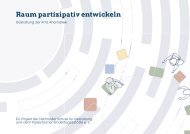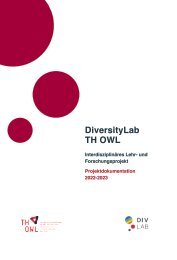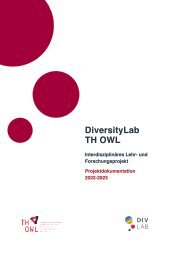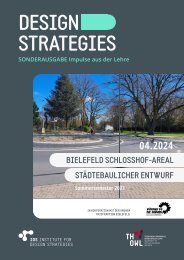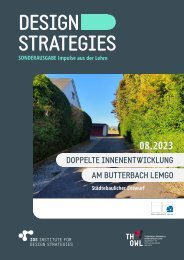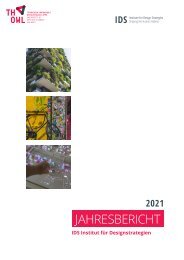Design Strategies IMPULSE - Sustainable Facades Vol 2
Report Winter Semester 2023/24
Report Winter Semester 2023/24
You also want an ePaper? Increase the reach of your titles
YUMPU automatically turns print PDFs into web optimized ePapers that Google loves.
Figure 9. Revised details - First alternative<br />
• A measure of the potential greenhouse gas<br />
emissions associated with the material expressed<br />
as -64 kg CO2 equivalent per square meter.<br />
• The wall is noted to accumulate 0.00 kg/m² of<br />
condensation, which implies excellent moisture<br />
management as no internal condensation is<br />
expected and the temperature of the inside<br />
surface is given as 18.8°C, which leads to a<br />
relative humidity on the surface of 54%. It‘s<br />
stated that mold formation is not expected<br />
under these conditions, indicating a healthy<br />
moisture level within the wall.<br />
Second Alternative:<br />
For second alternative I decided to use cellulose<br />
as an insulation and method is that they push the<br />
cellulose with high pressure inside of the cavity and<br />
also use bitumen coating for internal face of the wall<br />
due to moisturizing reasons.<br />
Calculations<br />
• The overall thermal transmittance of the wall<br />
is given as U=0.22 W/(m²K), which measures<br />
how well the wall can contain heat. standard<br />
(GEG 2020 Bestand) is U=0.24 W/(m²K) and<br />
the current configuration is better than the<br />
standard and it rated in excellent range.<br />
• The wall dries in 93 days. It‘s also noted that<br />
there is no condensate, meaning the wall is not<br />
expected to accumulate moisture internally.<br />
This section is rated as „excellent,“ showing it<br />
has good moisture management.<br />
• A damping of 35 means that the wall can<br />
significantly smooth out the highs and lows of<br />
the external temperature. So, if the temperature<br />
outside fluctuates greatly, inside the building,<br />
those fluctuations will be much less noticeable,<br />
helping to keep the indoor environment more<br />
stable and in this context, „non-relevant“<br />
suggests that due to the wall‘s high level of<br />
insulation, the phase shift is not a significant<br />
factor in its performance. Essentially, the<br />
insulation is so effective that the time it takes<br />
for the outside temperature to affect the inside<br />
is not a concern, as the temperature fluctuation<br />
is greatly dampened and it is in excellent rang<br />
and a phase shift of 13.2 hours means that if<br />
the temperature outside peaks at noon, that<br />
extreme temperature won‘t be felt on the inside<br />
until approximately 13.2 hours later.<br />
• Heat loss during the heating season 17 kWh/m²<br />
and the amount of non-renewable energy, over 117<br />
kWh/m², used in the production of the material. It<br />
includes energy from fossil fuels and nuclear energy.<br />
• A measure of the potential greenhouse gas<br />
emissions associated with the material expressed<br />
as -67 kg CO2 equivalent per square meter.<br />
• The wall does not accumulate condensate, and<br />
it also provides the drying reserve capacity and<br />
the minimum required protection, concluding<br />
that the moisture protection of this component<br />
is rated poorly and The absence of condensate<br />
across the materials suggests good moisture<br />
management within the wall structure the<br />
temperature of the inside surface of the wall and<br />
the relative humidity, which indicates that mold<br />
is not expected to form under these conditions.<br />
5. Conclusion<br />
In conclusion, this thesis has shown that wood fiber<br />
insulation enhances historic buildings‘ thermal<br />
performance and energy efficiency, notably in<br />
half-timber constructions. Its application not only<br />
maintains the structural integrity of these buildings<br />
but also significantly reduces U-values, underscoring<br />
its high efficiency. Furthermore, incorporating a<br />
vapor barrier with wood fiber insulation plays a<br />
pivotal role in controlling moisture transfer from<br />
the inside to the outside. This combination balances<br />
moisture control and insulation needs, ensuring the<br />
building‘s persistence and structural health. The<br />
total internal insulation thickness system ranges<br />
from 95 to 155 millimeters, accommodating various<br />
U-Value requirements. The insulation‘s U-value<br />
improves progressively with increased thickness,<br />
transitioning from 0.24 at 20 mm to 0.16 at 100<br />
mm. A 60 mm thickness was selected for its optimal<br />
balance of thermal performance, making a U-value<br />
that aligns with the standards set forth by the GEG<br />
and KfW and represents a common choice for<br />
diverse structural types. Additionally, the findings<br />
of this research confirm that this insulation method,<br />
including the vapor barrier, complies with current<br />
GEG and KFW regulations, reinforcing its applicability<br />
and relevance in contemporary sustainable building<br />
practice. This marks a significant contribution<br />
to sustainable renovation and conservation of<br />
historical architecture, offering a balanced approach<br />
to modern insulation techniques while respecting<br />
the heritage value of historic structures.<br />
7. References<br />
1. Federal Ministry for Economic Affairs and Energy<br />
(BMWi). (2018). Energy solutions made in Germany.<br />
Berlin, Germany.<br />
2. Federal Ministry for Economic Affairs and Energy<br />
(BMWi). (2020). Energy efficiency strategy for buildings.<br />
Berlin, Germany.<br />
3. Federal Republic of Germany. (2010). National heritage<br />
policy of Germany. Munich, Germany.<br />
4.Federal Ministry for Economic Affairs and Energy<br />
(BMWi). (2018). Climate action plan 2050. Berlin,<br />
Germany.<br />
5. Stefan Hulsbosch, Edwin J. van Dijk, Elisa C. Boelman,<br />
34<br />
ARTICLES<br />
<strong>Design</strong> <strong>Strategies</strong> <strong>IMPULSE</strong> – <strong>Sustainable</strong> Façades 04.2024 <strong>Design</strong> <strong>Strategies</strong> <strong>IMPULSE</strong> – <strong>Sustainable</strong> Façades 04.2024<br />
ARTICLES<br />
35






